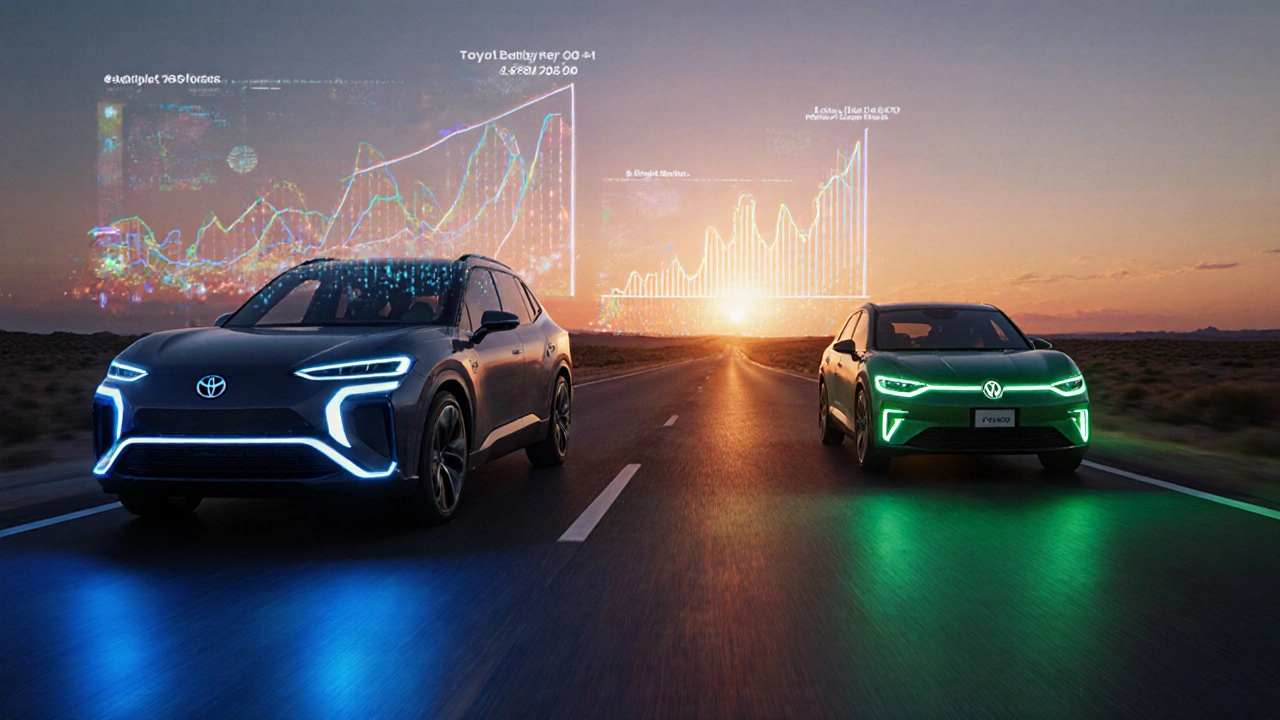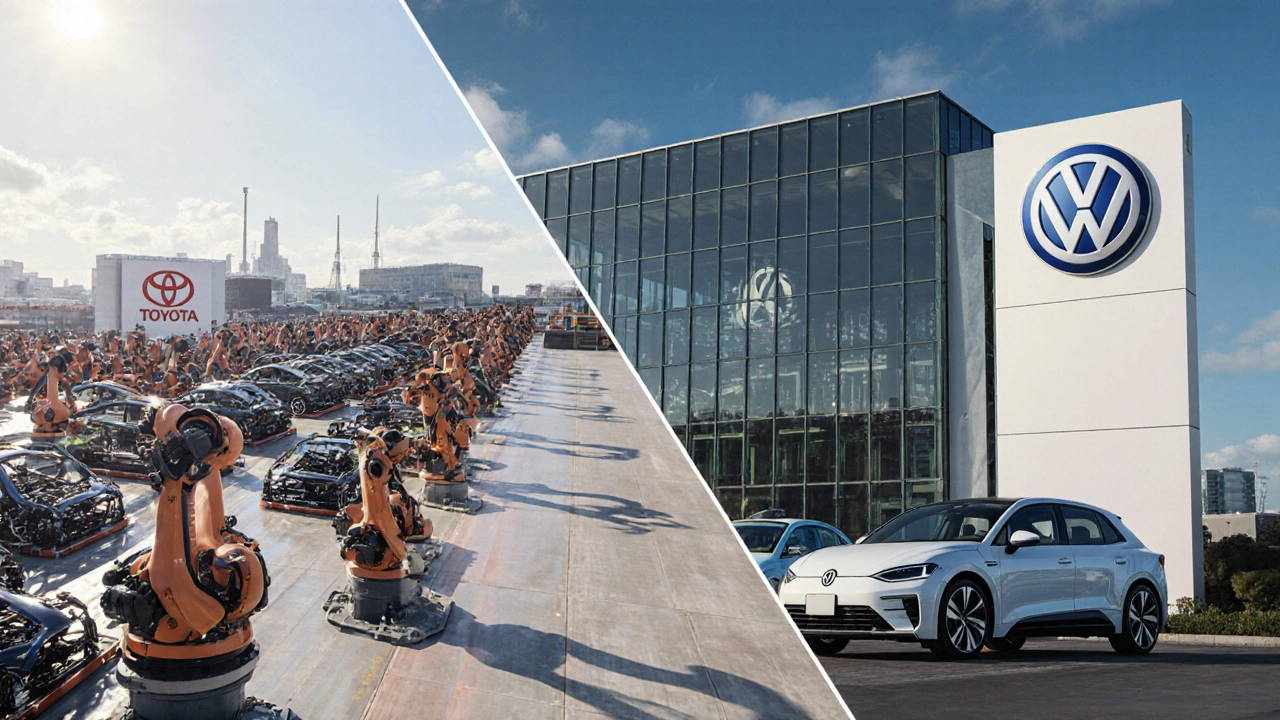Toyota vs Volkswagen Comparison Tool
Select Comparison Metrics
Comparison Results
Toyota vs Volkswagen—the two biggest auto groups—bring different strengths to the global market. When you hear the name Toyota you probably picture reliable sedans and a massive factory floor in Japan. Volkswagen, on the other hand, conjures images of the iconic Beetle and a sprawling European empire of brands. So, which of these two titans is actually bigger? Below we break down the numbers that matter—revenue, vehicle sales, market reach, and future‑focused electric‑vehicle (EV) plans—to give you a clear picture.
Key Takeaways
- In 2023 Toyota generated about $275billion in revenue, edging out Volkswagen’s roughly $250billion.
- Toyota sold 10.5million vehicles worldwide last year, while Volkswagen moved 9.3million units.
- Both groups dominate in different regions: Toyota leads in North America and Asia, Volkswagen holds the crown in Europe.
- Volkswagen’s EV sales grew 68% in 2023, surpassing Toyota’s 42% growth, but Toyota still sells more total EVs.
- Dealership networks in the U.S. favor Toyota with ~1,250 stores versus Volkswagen’s ~850.
What Toyota Actually Is
Toyota is a Japanese multinational automotive manufacturer headquartered in Toyota City, Aichi. Founded in 1937, the company pioneered the mass‑production of hybrid technology with the Prius and now offers a full lineup from compact cars to heavy‑duty trucks. Its core attributes include a 2023 revenue of $275billion, a global vehicle‑sales volume of 10.5million units, and a presence in over 170 countries.
What Volkswagen Actually Is
Volkswagen is a German automotive group headquartered in Wolfsburg. Established in 1937, it grew into a constellation of brands—Audi, Porsche, Škoda, SEAT, and others—covering every market segment. In 2023 the group reported revenue of $250billion and sold 9.3million vehicles worldwide, operating in more than 150 nations.
Revenue Showdown
Revenue is the most straightforward indicator of size because it reflects total sales across all business lines, including financing, parts, and services. According to the companies’ 2023 annual reports:
- Toyota posted $275billion, boosted by strong pickup sales in North America and a surge in hybrid demand.
- Volkswagen reported $250billion, helped by a rebound in European diesel models and a growing premium‑segment portfolio.
Both firms generate roughly the same amount of cash flow, but Toyota’s broader product mix gives it a slight edge in total revenue.
Vehicle‑Sales Comparison
Sales volume tells us how many actual cars roll off the line and into customers’ hands. The latest figures from the International Organization of Motor Vehicle Manufacturers (OICA) show:
- Toyota sold 10.5million units worldwide in 2023, ranking first among all automakers.
- Volkswagen moved 9.3million units, placing second globally.
When you break the numbers down by region, Toyota dominates North America (≈2.3million) and Asia‑Pacific (≈5.2million). Volkswagen leads Europe (≈4.0million) but lags in the United States.
U.S. Dealership Footprint
For most American shoppers, the size of a brand’s dealer network directly influences accessibility, service quality, and resale value.
- Toyota operates about 1,250 franchised dealerships across the United States, covering every major market.
- Volkswagen runs roughly 850 dealerships, concentrated in the Midwest and coastal corridors.
More dealerships typically mean shorter wait times for new‑car deliveries and easier access to parts and service.
Electric‑Vehicle (EV) Strategies
Both groups have announced ambitious EV roadmaps, but they differ in execution.
- Toyota plans to launch 15 new battery‑electric models by 2027, targeting a total of 3million EVs sold per year. In 2023, Toyota’s EV sales reached 480,000 units, a 42% year‑over‑year increase.
- Volkswagen aims for 70% of its European sales to be electric by 2030. Its ID. series helped the group ship 710,000 EVs in 2023, a 68% jump.
Volkswagen’s dedicated EV platform gives it a faster growth rate, yet Toyota still moves more total EVs because of its massive overall sales base.
Production Capacity and Global Footprint
Manufacturing scale matters for cost efficiency and resilience.
- Toyota runs 27 vehicle‑assembly plants in Japan, plus 15 in North America, 10 in Asia‑Pacific, and 9 in Europe, cranking out about 10million units annually.
- Volkswagen operates 120 facilities worldwide, including 10 in Germany, 8 in China, 6 in the United States, and a growing presence in Brazil and India.
Volkswagen’s broader plant count reflects its multi‑brand strategy, while Toyota’s production is heavily weighted toward its own models.
Brand Portfolios
Both groups own multiple sub‑brands that target specific buyer segments.
| Group | Luxury / Premium | Mid‑range | Budget |
|---|---|---|---|
| Toyota | Lexus | Toyota | Scion (defunct) |
| Volkswagen | Audi, Porsche | Volkswagen, Škoda | SEAT, Volkswagen (entry‑level) |
Lexus consistently ranks among the most reliable premium brands, while Audi and Porsche give Volkswagen a strong foothold in the high‑end market.

Side‑by‑Side Comparison Table
| Metric | Toyota | Volkswagen |
|---|---|---|
| Revenue (2023) | $275billion | $250billion |
| Global vehicle sales | 10.5million | 9.3million |
| U.S. dealerships | ~1,250 | ~850 |
| 2023 EV sales | 480,000 | 710,000 |
| EV growth YoY | 42% | 68% |
| Number of brands | 2 (Toyota, Lexus) | 5 (Volkswagen, Audi, Porsche, Škoda, SEAT) |
| Key markets | North America, Asia‑Pacific | Europe, China |
What the Size Difference Means for You
If you’re choosing a dealer or a brand, consider what “bigger” actually influences:
- Service network: Toyota’s larger U.S. dealer base often translates to shorter wait times for parts and service appointments.
- Resale value: High‑volume models tend to retain value better; Toyota’s best‑selling trucks and SUVs usually command premium used‑car prices.
- Innovation pace: Volkswagen’s aggressive EV push may offer more cutting‑edge electric options sooner.
- Brand personality: Lexus appeals to luxury buyers looking for refinement, while Audi and Porsche cater to performance‑oriented shoppers.
In short, Toyota is slightly bigger by revenue and total units sold, while Volkswagen leads in EV momentum and brand diversity.
Common Pitfalls When Comparing Giants
Don’t let a single metric dictate your decision. Here are a few traps to avoid:
- Assuming higher revenue always means better quality – both companies produce reliable cars, but reliability varies by model.
- Focusing only on global sales and ignoring regional strengths – if you live in the Midwest, Volkswagen’s dealer network might be more convenient.
- Overlooking future‑technology roadmaps – a brand that seems smaller today could dominate the EV market in five years.
Bottom Line
When you strip away the hype, Toyota edges out Volkswagen in overall size thanks to higher revenue and more vehicles sold worldwide. However, Volkswagen’s larger brand portfolio and faster‑growing EV segment make it a formidable competitor, especially for buyers who prioritize electrification.
Lexus is Toyota’s luxury division, launched in 1989, known for premium sedans and hybrids.
Audi is Volkswagen Group’s premium brand, offering sport‑styled sedans, SUVs, and the e‑tronic lineup.
Revenue refers to the total income a company generates before expenses; in 2023 Toyota reported $275billion while Volkswagen posted $250billion.
Global vehicle sales measure the number of cars delivered to customers worldwide in a given year.
Electric‑vehicle strategy outlines a manufacturer’s roadmap for battery‑electric models, charging infrastructure, and investments.
China is the world’s largest auto market, accounting for roughly 30% of global vehicle sales.
Frequently Asked Questions
Which company sells more cars in the United States?
Toyota leads the U.S. market with about 2.3million units sold in 2023, while Volkswagen moved roughly 800,000 cars.
Is Volkswagen larger than Toyota in Europe?
Yes. Volkswagen’s European sales topped 4million units in 2023, dwarfing Toyota’s roughly 1.5million units in the region.
Which brand has a bigger electric‑vehicle lineup?
Volkswagen currently offers a larger pure‑EV lineup under its ID. series and upcoming models, though Toyota’s hybrid portfolio remains the most extensive.
How many dealerships does each brand have in the U.S.?
Toyota operates around 1,250 franchised dealers, whereas Volkswagen runs about 850.
Which company should I choose for better resale value?
Generally, Toyota’s high‑volume models—especially the Tacoma, 4Runner, and RAV4—hold resale value better than comparable Volkswagen models.


Comments
vidhi patel
It is evident that the comparative figures within the article contain several inconsistencies, particularly concerning the reported revenue conversion rates and the classification of dealer counts; such discrepancies undermine the credibility of the analysis and warrant immediate correction.
October 12, 2025 at 05:51
Priti Yadav
All of those numbers are obviously fed by the shadowy consortium that manipulates automotive data to hide the true dominance of secret electric cartels, and anyone who trusts the official reports is being deliberately misled.
October 23, 2025 at 19:38
Ajit Kumar
The magnitude of the automotive industry cannot be reduced to a simple spreadsheet of revenue and unit sales; rather, it embodies a complex network of supply chains, labor practices, and geopolitical influences that extend far beyond the surface metrics presented. When evaluating the size of Toyota and Volkswagen, one must consider not only the headline figures but also the underlying corporate governance structures that dictate strategic direction. Toyota’s adherence to the kaizen philosophy fosters incremental efficiency gains that accumulate into substantial competitive advantages over time. Conversely, Volkswagen’s aggressive pursuit of platform sharing across its multi‑brand portfolio accelerates economies of scale, yet it also introduces systemic risk through cross‑contamination of engineering flaws. The disparity in electric‑vehicle growth rates reflects divergent policy environments, with Europe incentivizing rapid electrification, thereby favoring Volkswagen’s ID series, while Japan’s regulatory framework remains more cautious, tempering Toyota’s EV expansion. Moreover, the sheer number of manufacturing facilities operated by each group bears a direct correlation to regional employment stability, a factor often neglected in superficial comparisons. Toyota’s concentration of production in fewer, highly automated plants yields higher per‑unit productivity but may exacerbate vulnerability to localized disruptions. In contrast, Volkswagen’s dispersed network mitigates such risks at the cost of increased logistical complexity. The environmental impact of each corporation’s vehicle lineup also warrants scrutiny; Toyota’s longstanding commitment to hybrid technology provides a transitional pathway that reduces emissions incrementally, whereas Volkswagen’s reliance on pure‑electric models promises a more abrupt, albeit currently resource‑intensive, shift. Cultural brand perception further influences market share, with consumers globally associating Toyota with reliability and Volkswagen with performance heritage. It is also essential to acknowledge the role of financial services subsidiaries, which augment revenue streams and can obscure the true profitability of the core automotive divisions. Finally, any legitimate assessment must incorporate forward‑looking indicators such as research and development expenditure, strategic partnerships in autonomous driving, and the capacity to adapt to emerging regulatory standards that will shape the next decade of mobility.
November 4, 2025 at 08:25
Jane San Miguel
One must appreciate the nuanced distinction between sheer fiscal magnitude and the intellectual capital embedded within each conglomerate, a perspective that the article regrettably omits.
November 15, 2025 at 22:11
Kasey Drymalla
Whoa drama alert, the numbers are a total circus.
November 27, 2025 at 11:58
Dave Sumner Smith
The published statistics are deliberately fabricated by a cabal of industry insiders who aim to steer consumer perception while siphoning off hidden profits.
December 9, 2025 at 01:45
Cait Sporleder
While the notion of a covert consortium manipulating data may appear sensational, it is worthwhile to examine the mechanisms through which market narratives are constructed, including the strategic release of selective performance metrics, the orchestration of press releases timed to coincide with earnings calls, and the subtle influence exerted by lobbyists on regulatory reporting standards; such an inquiry reveals the intricate dance between corporate ambition and public transparency, prompting a deeper appreciation for the layered complexity that underpins seemingly straightforward automotive statistics.
December 20, 2025 at 15:31